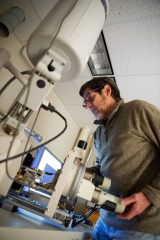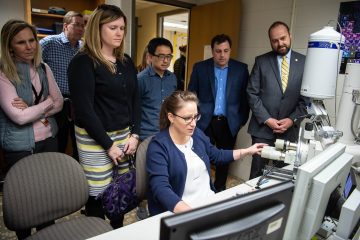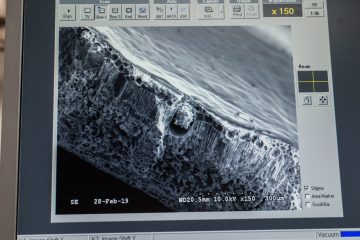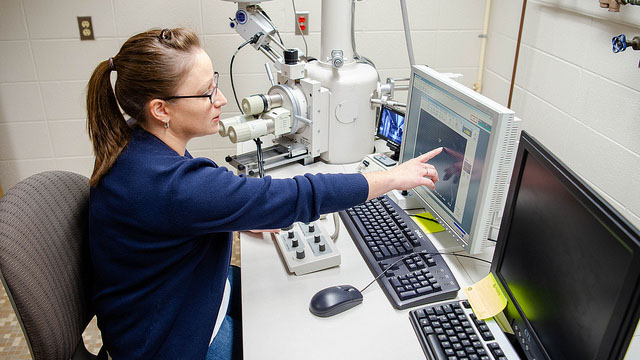Students at the University of Wisconsin Oshkosh are getting hands-on experience with valuable instrumentation used for scientific research—thanks to a significant donation from Oshkosh Corporation.
“This is really tremendous,” Chancellor Andrew Leavitt told a group of faculty scientists, students and representatives of Oshkosh Corporation who gathered this week for a ceremonial dedication. “This really sets us up for the future.”
Located in the Halsey Science building, a gently-used Scanning Electron Microscope (SEM) provides state-of-the-art equipment that is completely digital. It replaces a 25-year-old SEM model that originally would only take Polaroid photos (it was later retrofitted to collect digital images).
 The microscope donation was made possible when longtime Hitachi service technician Don Gramer inquired about UW Oshkosh’s interest in the microscope being replaced at Oshkosh Corporation. Gramer talked to representatives at Oshkosh who agreed to donate the microscope.
The microscope donation was made possible when longtime Hitachi service technician Don Gramer inquired about UW Oshkosh’s interest in the microscope being replaced at Oshkosh Corporation. Gramer talked to representatives at Oshkosh who agreed to donate the microscope.
With the new microscope, a beam of electrons projects the surfaces of objects in 3-D and at very high resolution.
“We have had electron microscopes at UWO since the early 1970s, and they provide students with hands-on experience with valuable instrumentation that is used for research,” said Todd Kostman, biology co-chair and director of the electron microscope facility. “The experience is difficult to come by as very few institutions our size still offer this training. At larger institutions, undergraduate students would not be allowed to train on the instrumentation.”
Biology graduate student Lyndsay Poeschl, of Oshkosh, has been spending time examining beetles under the microscope. Her thesis adviser, Rob Mitchell, an entomologist at UWO, was collaborating on a project with Jodi Sedlock, of Lawrence University. The project dealt with acoustic biology, and they needed some SEM work done.

Poeschl knew how to use the SEM and was able to gather images from the specimens the professors had previously recorded.
“My thesis essentially developed from this collaboration into the survey it is today,” she said.
Poeschl is studying three males and three females of 45 different beetle species. She is measuring ridge spacing from each beetle she images and looking for statistical variation within and among species and sex to correlate structure with insect sound production.
She said stridulation—the production of sound by rubbing together body parts—is accomplished by the beetles through a series of head bobbing motions, which allow morphological structures to contact each other.
It is believed, upon completion, the research will be the largest survey of its kind.
Digital age
The donated microscope is about 10 years newer than the version in the biology department that was installed in 1994.
Valued at about $200,000 when new, the microscope is fully digital and software-driven. It has a new Oxford X-ray spectroscopy system that Kostman said is a “giant improvement” on the former Thermo system.
 “It has a much better and higher resolution backscatter electron detector, and the Hitachi technician also re-installed the cathode luminescence detector and it works better than it did on the old scope,” Kostman said, adding that he appreciated Oshkosh Corporation’s willingness to load the donated microscope onto a pickup truck and deliver it directly to the Halsey Science Center basement laboratory.
“It has a much better and higher resolution backscatter electron detector, and the Hitachi technician also re-installed the cathode luminescence detector and it works better than it did on the old scope,” Kostman said, adding that he appreciated Oshkosh Corporation’s willingness to load the donated microscope onto a pickup truck and deliver it directly to the Halsey Science Center basement laboratory.
Kevin Crawford, UW Oshkosh professor of chemistry and director of the Sustainability Institute for Regional Transformations, said the microscope donation kept the instrument from being discarded.
“The SEM replaces a much older microscope that was very difficult to maintain due to its age. Our students in biology and materials research areas will now be trained on a much newer electron microscope, better preparing them for their careers and the SEM (from Oshkosh Corporation) will see additional use rather than becoming scrap,” he said.
Rob Messina, senior vice president and chief technology officer with Oshkosh Corporation, called the excitement at UW Oshkosh related to the donated electron microscope “heartwarming.”
He said the scientific research equipment helps train some of the best workers and helps better the community. Over the years, approximately 650 UW Oshkosh graduates have become Oshkosh Corporation employees.
Students and faculty from many UW Oshkosh science departments, including those from geology, physics, chemistry and biology, are expected to use the electron microscope technology.
Poeschl has worked with both microscopes. She said the new Hitachi S-300N is more user-friendly than the old Hitachi 2460N and allows for higher resolution imaging. She said she is hopeful to use her SEM skills in a future career.
Learn more:

